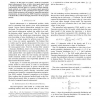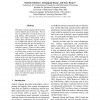490 search results - page 3 / 98 » Speech modeling based on committee-based active learning |
NAACL
2004
13 years 7 months ago
2004
The regular occurrence of disfluencies is a distinguishing characteristic of spontaneous speech. Detecting and removing such disfluencies can substantially improve the usefulness ...
IJCNN
2006
IEEE
13 years 11 months ago
2006
IEEE
— In this paper we present a method of sequential speech enhancement, where we infer clean speech signal using a Rao-Blackwellized particle filter (RBPF), given a noisecontamina...
ICPR
2010
IEEE
13 years 7 months ago
2010
IEEE
This paper concentrates on speech duration distributions that are usually invariant to noises and proposes a noise-robust and real-time voice activity detector (VAD) using the hid...
EMNLP
2010
13 years 3 months ago
2010
This paper examines tagging models for spontaneous English speech transcripts. We analyze the performance of state-of-the-art tagging models, either generative or discriminative, ...
MLMI
2007
Springer
13 years 12 months ago
2007
Springer
Abstract. Prosody has been actively studied as an important knowledge source for speech recognition and understanding. In this paper, we are concerned with the question of exploiti...


